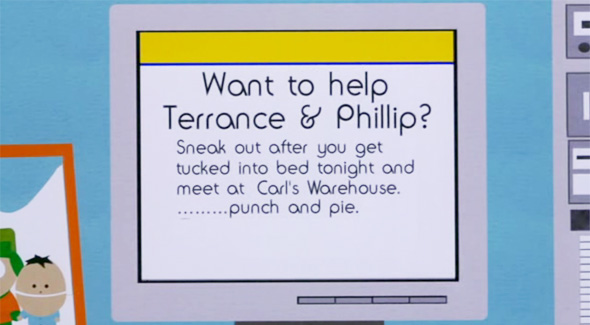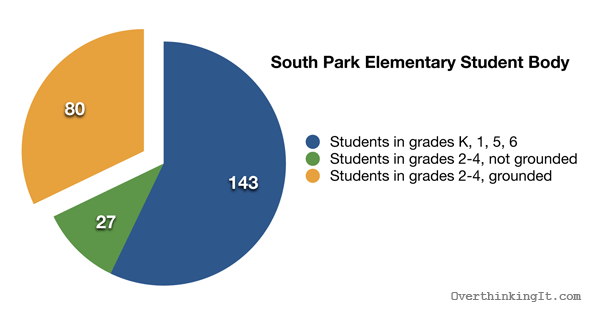“More people will come if they think we’ll have punch and pie!”
Many have colloquially known that punch and pie is an effective marketing/publicity tool to incentivize attendance at events, but its precise quantitative effect on attendance has largely been left to conjecture…until now, that is.

Here, we shall use the case study opportunity presented in South Park: Bigger, Longer, Uncut as a basis for extrapolating a general statistical model to demonstrate the effect of offering punch and pie as an attendance incentive.
Let’s recap the scenario presented in South Park: Bigger, Longer, Uncut:
Kyle, Kenny, Cartman, and Stan are trying to save Terrence and Phillip from execution, but they can’t do it alone. They need to “round up all the grounded kids in town” to join their cause, La Resistance. “All the grounded kids in town,” however, is quite a large target audience, so let’s assume that what the organizers really mean is all the grounded kids at their school in their peer group (defined as plus or minus one grade level from theirs). Given an estimate of the student body of South Park Elementary at around 250 students, grades K-6, and an estimated 75% grounding rate (for seeing the Terrence & Phillip Movie), that leaves our organizers with a target audience of only about 80 kids.

To reach this target audience, the organizers sent an “all access email” announcing their organizational meeting. Cartman famously suggests that they advertise “punch and pie” to boost attendance.
Initial turnout exceeded the organizers’ expectations:

Twelve kids showed up to the meeting (in addition to the four organizers). Now we can start to answer the question at hand: what impact did the promise of punch and pie have on attendance? How many kids would have attended if punch and pie were not promised?
The actual absence of punch and pie at the meeting presents us with an interesting scenario. In this case, two kids immediately get up when they learn there are no such refreshments at the meeting. One may be tempted to conclude that the punch & pie only accounted for drawing these two freeloaders. In fact, the lack of punch and pie shows simply that among the twelve that showed up to the meeting, those two were the only ones whose interest in attending the meeting was solely based on punch and pie. The rest of the twelve (now ten) either came solely out of interest in La Resistance or out of a combined interest in La Resistance and punch & pie.
The group whose interest in La Resistance alone was enough to guarantee their attendance would not have been affected by the offer of punch and pie; they would have come regardless. This group was undoubtedly a small minority. Given the typical distribution of committed partisans among any newly formed group, Gregory and Wendy were likely the only ones who fell into this group. Which means that for the remaining eight, the promise of punch and pie was the deciding factor in their attendance.

Now we have enough information to determine the drawing power of the punch and pie. Without any sort of incentive, the organizers would have probably only gotten Gregory and Wendy to show up, representing only 2.5 % of the target audience. With the promise of punch and pie, they were able to get twelve total to show up, or 15 % of the target audience, a 500% performance improvement over the incentive-less scenario. After the two freeloaders leave, they still have succeeded in drawing in 12.5 % of the target audience, a 400 % performance improvement.
Let us now apply this rule to determine the effect of offering punch and pie to other attendance scenarios.
- In 2008, the Florida Marlins drew the least number of fans in baseball: 1,335,075, only 45.9% of capacity. Offering punch and pie would have drawn far more fans than stadium capacity would allow: 6,675,375, or 230 % of capacity.
- Barack Obama’s inauguration drew approximately 1 million spectators. Offering punch and pie would have drawn 5 million spectators, or 250% of the Mall’s capacity.
- Last week’s staged reading of “Aux Legumes,” an obscure French literary work, drew 15 people to Revolution Art Space in Brooklyn, New York. Offering punch and pie would have drawn 100 people, since the effect of the incentive is amplified by the pervasive sense of irony in that part of the country.
Conclusion
More people will come if they are led to believe that punch and pie will be served.
Logical, useful, practical, brilliant.
I tip my cap to you.
Hmm. It seems that you need to differentiate between events that actually deliver on the punch and pie promise and those that do not serve punch and pie. If a large number of event organizers defaulted on their punch and pie, the punch and pie promising event market would collapse and your general model would be worthless. Attendees would factor in the risk of not receiving punch and pie, and you’d get negative sentiment towards punch and pie promisers.
Finally, a USEFUL case study. Lovesit.
I think it you should do a graph of percentage of overthinkingit.com posts that have graphs in them vs. asianness of the author :)
Even punch and pie wouldn’t bring people out to see the Marlins. Rum and Cuban sandwiches, maybe.
Very rarely during my college experience did an ad go out for something that didn’t include free food of some kind. And I, being an event planner at my college, totally understood the value of saying there will be free cookies or pizza provided. Security meetings (for concerts and high-profile lectures) always had pizza, for example, and the “volunteers” (since a lot of them were required to go in order to keep some other position) would complain whenever it wasn’t there right as they walked in the door. I always was annoyed with people that came to the very beginning of a gathering, grabbed some of whatever was offered, and then left (sometimes after standing there for a few seconds to try to look like they cared), or the people that would see the stuff and ask what the meeting was about either as they grabbed or just before grabbing at food- and they’d leave as soon as they had enough in their hands. What irked me the most, though, was when passerby would grab something and walk away without even asking or seeming to care what was going on- they just felt entitled to whatever food or treat was on the table/counter/whatever.
To add to what Hit Dog was saying, I think we humans as a race need to move beyond the cliche of “punch” and “pie.” Rum and cubanos is a step in the right direction. For the snootier of us, how about Cosmos and caviar? Texans can go for beer and barbecue. We New York Jews would go for seltzer and a schmear (on a bagel, naturally).
Punch and pie will also add to the obesity epidemic. Punch is basically sugar, and pie is basically sugar + lard. Think of the diabetics! Do you not want them at your meetings, Mark? Do you not want them?
Speaking of diabetes, it’s interesting that in the “Elementary School Musical” episode, Cartman makes fun of another kid for his diabetes, when Cartman is clearly a prime candidate for developing diabetes himself.
Cartman with diabetes is clearly a plot line waiting to be explored by South Park.
Hmmm, this page is first on google for ‘punch and pie marketing’. Maybe you should tag this ‘SEO’ as well…
Mlwaski: I realize now that I never see, “Free low-fat yogurt!” or, “Veggie trays!” in ads. Or, well, I never saw them in college, and the ads for attendance at meetings and such for the school district I work with always say at their most vague, “Refreshments provided,” (which is an understood “cookies, coffee, and juice”) and often say there will be pizza or muffins (and the places those come from are also understood). I think the healthiest food I saw in college as a pull for an event or gathering was, “Yummy, yummy tofu,”-esque stuff. Food that only appealed to the hardcore vegetarians/vegans that would have been going to the thing(s) anyway because they were meant for the uber-environmentalists that weren’t shaving or washing their hair and crap like that (while they, of course, drove <1 mile to class). I think the diabetics are S.O.L., unfortunately, since the stuff that draws people in is the stuff diabetics need to be careful about. Pizza, ice cream, cookies, cake, etc. Non- or low-fat foods and fruits and veggies just don’t get enough publicity. It’s kind of sad for them. They just need a chance.
Lee: (Typing out loud ish) If the writers went for a “Cartman has diabetes” plot, they’d probably end the episode with it being a false alarm somehow. I’m picturing Cartman being an even bigger a**hole than normal but everyone going with it because oh my gosh, he has diabetes. He’d totally hold it over their heads, and then at the end of the episode it would be revealed that he was diabetes-free- and he knew the whole time. Or maybe he’d think it’s true and do something like give away all of his stuff because he thinks he’s going to die (and still holding it over everybody’s heads- I just can’t picture him NOT milking it) and then he’d be totally upset when he realizes he did it for nothing.
Do you (or does anyone else) currently watch _South Park_? I’m basing my assumption on the first few seasons, so I could be totally off-base in how I think the writers would approach a “Cartman has diabetes” idea.
The punch and pie generation is coming to a close. Unfortunately for us pie eaters the new pie is liquor and the new punch is liquor.